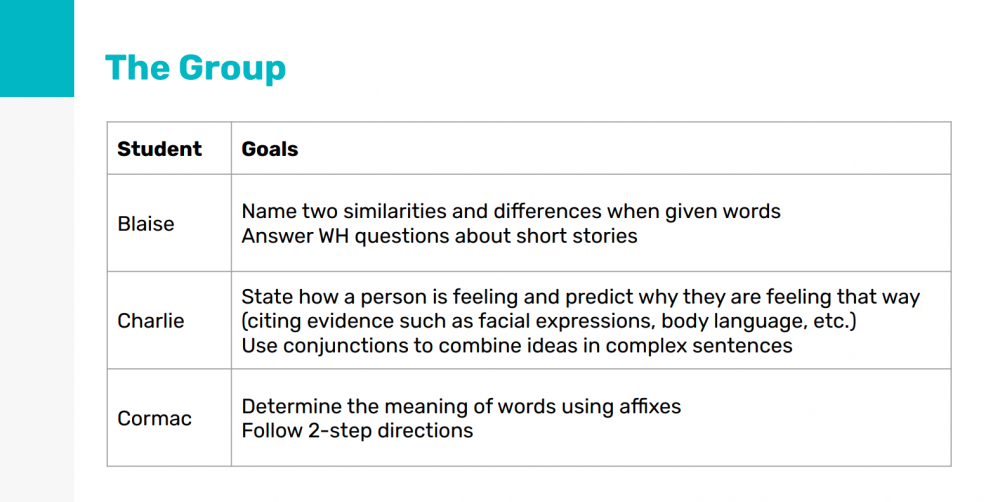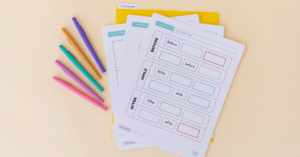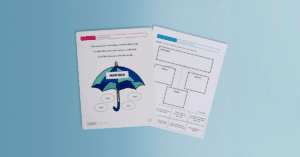Listen on Apple Podcasts Listen on Spotify
Today’s Topic: Literacy-Based Therapy Plans for Later Elementary
I’m going to introduce you to three students who are targeting a mix of vocabulary, language, and social language goals:

You can see that Blaise is working on compare/contrast and comprehension goals; Charlie is working on perspective-taking, sharing evidence to support inferences, and creating complex sentences; and Cormac has a vocabulary goal and is working on following directions.That’s a lot of goals to plan for in a mixed group… but you can plan for that!
I’ll show you how — and it will only take ten minutes.
(Yes, really.)
In this podcast episode, I’ll walk you through plans for each step of the literacy-based framework, and share ideas + activities that target all of the students’ goals.
Here’s what we discussed:
[1:10] Therapy Ideas for Step 1 (Pre-Story Knowledge Activation)
[4:50] Therapy Ideas for Step 2 (Reading)
[5:00] Therapy Ideas for Step 3 (Post Story Comprehension)
[6:10] Therapy Ideas for Step 4 (Skill Practice)
[10:00] Therapy Ideas for Step 5 (Parallel Story)
Want to hear more about this topic? Click here to see this month’s content!
Links Mentioned
– The SLP Now One-Page Literacy-Based Therapy Unit Planner
– SLP Now Membership
– Falling for Jazz
Subscribe & Review in iTunes
Are you subscribed to the podcast? If you’re not, subscribe today to get the latest episodes sent directly to you! Click here to make your listening experience auto-magic and as easy as possible.
Bonus points if you leave us a review over on iTunes → Those reviews help other SLPs find the podcast, and I love reading your feedback! Just click here to review, select “Ratings and Reviews,” “Write a Review,” and let me know what your favorite part of the podcast is.
Thanks so much!
Transcript
Marisha: Next step is later elementary. So with this group we also have three students, Blez, Charlie and Cormack, and they have a mix of vocabulary, language and social language goals. So Blez is working on compare and contrast. So, naming similarities and differences for vocabulary words, and she also has some comprehension goals. So she's working on answering Wh questions. Charlie is working on stating how a person is feeling and predicting why they're feeling that way. So perspective taking and being able to cite evidence to support his inferences related to that. And then he's also working on creating complex sentences. And then Cormack has the vocabulary goal determining the meaning of words using affixes and then following two-step directions.
So for this group, because they are at a higher level, we are going to be using a fiction article and we'll dive into the planning there. So this is an article about a boy who realizes that he really loves jazz music. So I think this is one that's relatable to those older students. I'm sure they have their favorite genre of music. So it opens up first discussion about the different genres and what we like about different music and all of that. So, for their plan, I just, again, if I open up that organizer, I'll just write the name of the article, which is available on Read Works. It's a free resource and they have some really amazing articles. And then I just recap the skills, so I know what I'm working on. And then for this particular group, I would do a quick article walk. So I would just open up that article.
So I'd open this up here. So I'd opened the Read Works article, and then it does ask you to log in, but we would just look at the picture. We'd maybe look at a couple of sentences and then again, fill in the story grammar organizer so that we can start to make some smart guesses about what the story is about. And then again, if the students really struggle with that, we might do that virtual field trip. We might listen to some jazz music. We might watch a video about different jazz musicians and get a little bit of context. We might just do some... For this age group, they should have... It's based on their goals. It looks like they've got their foundational vocabulary down. So we can do some pre-teaching of the vocabulary words that they'll need to comprehend this unit, and so those words are identified for us in the actual unit. I'll get that pulled up too.
So we have, let's see... So we identified the common prefixes and suffixes, so that can help us with a student working on affixes. So we might pre-teach one of those, or I think it could still benefit the students to pre-teach some tier two vocabulary words as well, because we can still use that for the student who's working on compare and contrast and working on creating those complex sentences. Those are all skills that we could easily target in that type of activity. And it's not going to hurt them by any means, and that could be a really fun activity. So those are all things that I would do for step one.
Then for step two, we would go ahead and actually read the article. I might read it. I might have the students read it. Some of the Read Works articles have audio recordings, so that's pretty fun. And yeah, so that's what we would do there. And then for the story comprehension, our students are working on... It sounds like some of them are still working on literal questions and inferential questions. So I would also pull the question list included in the unit and dive into that.
And then I think it would also be a great activity to revisit that story grammar organizer and ask those comprehension questions of, who is in the story? When did it happen? Where did it happen? Et cetera, et cetera. And moving through that framework, just to make sure that they understood the article. And then we can dive into the literal and inferential questions, and if they struggled with the story grammar, we might revisit the article. Maybe I'll have to reteach some of the vocabulary if that's where the difficulty was, but this is a very dynamic process. And we just get to see how our students perform and then decide what step makes sense.
And then the next step is to dive into the actual skill activities. And so at this point, given these goals, I think we would've probably spent about one session, maybe two sessions if they didn't have a lot of pre-story knowledge, but it would've taken us one or two sessions to do that, and then go through the reading and then about a session for the comprehension, depending on how much support they need there. And the cool thing is for the students who are not working on comprehension goals, one of the students is working on creating complex sentences. So even though we're in the story comprehension step, I'm going to give all of the questions that involve because and before, and all of those conjunctions, I'm going to throw those to the student working on complex sentences so that he has an opportunity to practice using those, or I'm very strategically recasting the student's answers to include those conjunctions in all of that.
So it's very strategic and yeah, we're targeting all of the student's goals throughout all of the steps. And then when we get to the actual focus skill activities, I think, of course we want to use the visuals. If we haven't taught the student what affixes are, we're going to pull out that visual and do some teaching there. And I think that if it doesn't have to be one-on-one, we can do the teaching activity as a group. It definitely won't hurt the other students to hear what someone else is working on and then they can help support and kind of support the student and also help scaffold that skill. So it's really cool to see that. But I would just pull the visuals for affixes. I would pull the visuals for comparing and contrasting. I have a nice little cheat sheet that helps make it easy for students to identify similarities and differences.
And then I have a cheat sheet with all the different emotions on it. And then I might pre-teach some of the emotions that I know are in the story and we might do some activities with that. So that's what the teaching would look like. And then in terms of the actual practice, I think it would be very beneficial... All of these students have some kind of vocabulary goals, so they would all have a vocabulary journal. So if we go back to their goals, so Blez is working on naming similarities and differences. So I would give her some tier two vocabulary words, and she would work on identifying the similarities and differences. And Charlie doesn't have a vocabulary goal, but I think I would have him do the same type of journal as Blez because comparing and contrasting involves a lot of... He would have to use some pretty complex syntax to successfully compare and contrast there, so we would do some of that.
And then Cormack is working on affixes. So I would build a Google slide for him with the affix at the top or the middle of the page, and we would work on finding examples of the words that have that prefix or suffix, whatever we're targeting, and then writing sentences and all of that based on those words. So, that's what we would do there. And then we would wrap up and fill in the graphic organizer again and then create a parallel story. So for this example, it's a story about how a boy discovered that he loved jazz music so they can make a story about the first time they heard a certain genre of music or just anything related to their experience with music. It's really interesting to see how the students take this to a different level.
And this is extremely applicable because all of these students are working on retell, but it's also an opportunity to embed the vocabulary we targeted throughout the unit. It's an opportunity for the student working on complex sentences to pull those in, so lots and lots of learning opportunities and just practice opportunities throughout this unit.
So, that brings us to the end of our unit for our upper elementary students. So it depends on the dynamics of the group. So sometimes each student makes their own story. Sometimes it's really hard to manage. It depends on how the group is doing and how independent they are. If they are fairly independent and they can do their own writing, they can fill in their own graphic organizer and they just need a little bit of support, I think it would make sense for them to make their own. But if they all need a lot of support, than it is a little bit harder to make that happen, especially as we get into the older grades, that becomes much more feasible.
Sign up to receive email updates
Enter your name and email address below and I'll send you periodic updates about the podcast.




Reader Interactions